engine coolant TOYOTA TACOMA 2018 (in English) User Guide
[x] Cancel search | Manufacturer: TOYOTA, Model Year: 2018, Model line: TACOMA, Model: TOYOTA TACOMA 2018Pages: 696, PDF Size: 11.72 MB
Page 512 of 696
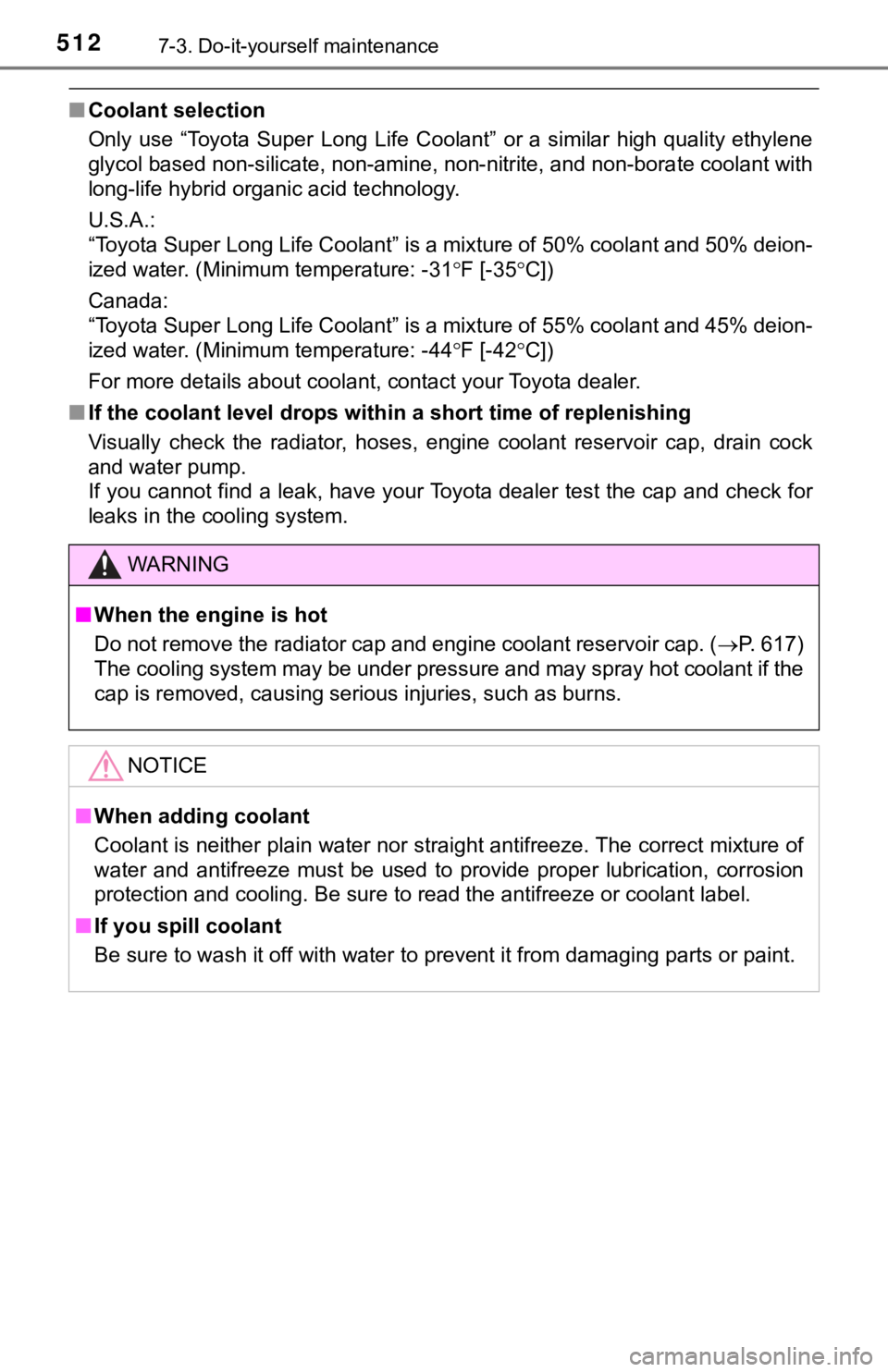
5127-3. Do-it-yourself maintenance
■Coolant selection
Only use “Toyota Super Long Life Coolant” or a similar high quality ethylene
glycol based non-silicate, non-amine, non-nitrite, and non-bora te coolant with
long-life hybrid organic acid technology.
U.S.A.:
“Toyota Super Long Life Coolant” is a mixture of 50% coolant and 50% deion-
ized water. (Minimum temperature: -31 F [-35 C])
Canada:
“Toyota Super Long Life Coolant” is a mixture of 55% coolant and 45% deion-
ized water. (Minimum temperature: -44 F [-42 C])
For more details about coolant, contact your Toyota dealer.
■ If the coolant level drops within a short time of replenishing
Visually check the radiator, hoses, engine coolant reservoir ca p, drain cock
and water pump.
If you cannot find a leak, have your Toyota dealer test the cap and check for
leaks in the cooling system.
WARNING
■ When the engine is hot
Do not remove the radiator cap and engine coolant reservoir cap . (P. 617)
The cooling system may be under pressure and may spray hot coolant if the
cap is removed, causing serious injuries, such as burns.
NOTICE
■ When adding coolant
Coolant is neither plain water nor straight antifreeze. The cor rect mixture of
water and antifreeze must be used to provide proper lubrication , corrosion
protection and cooling. Be sure to read the antifreeze or coolant label.
■ If you spill coolant
Be sure to wash it off with water to prevent it from damaging p arts or paint.
Page 564 of 696
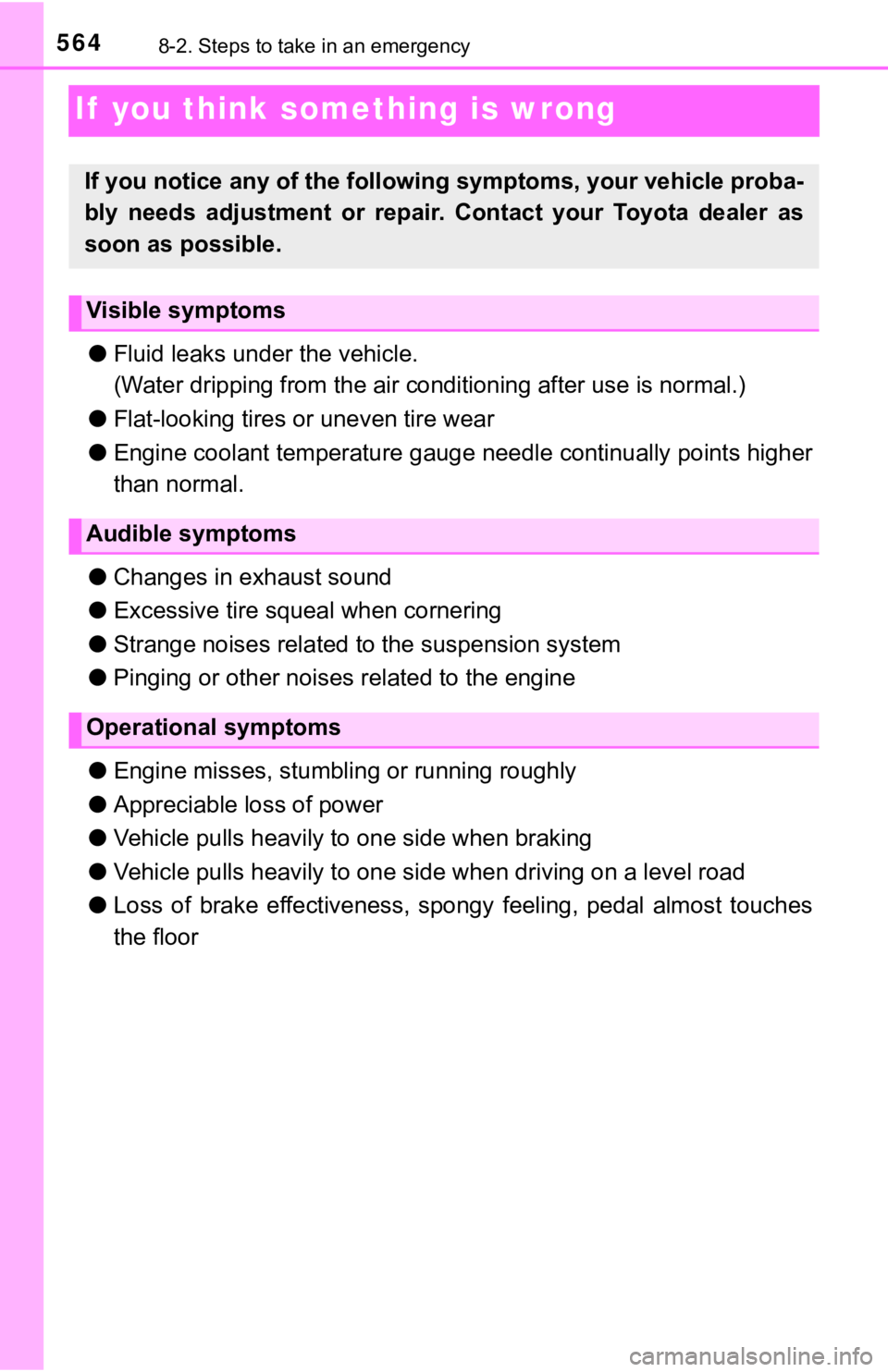
5648-2. Steps to take in an emergency
If you think something is wrong
●Fluid leaks un der the vehicle.
(Water dripping from the air conditioning a fter use is normal.)
● Flat-looking tires or uneven tire wear
● Engine coolant temperature gauge needle continually points high er
than normal.
● Changes in exhaust sound
● Excessive tire squeal when cornering
● Strange noises related to the suspension system
● Pinging or other noises related to the engine
● Engine misses, stumbli ng or running roughly
● Appreciable loss of power
● Vehicle pulls heavily to one side when braking
● Vehicle pulls heavily to one s ide when driving on a level road
● Loss of brake effectiveness, spongy feeling, pedal almost touch es
the floor
If you notice any of the followi ng symptoms, your vehicle proba -
bly needs adjustment or repair. Contact your Toyota dealer as
soon as possible.
Visible symptoms
Audible symptoms
Operational symptoms
Page 574 of 696
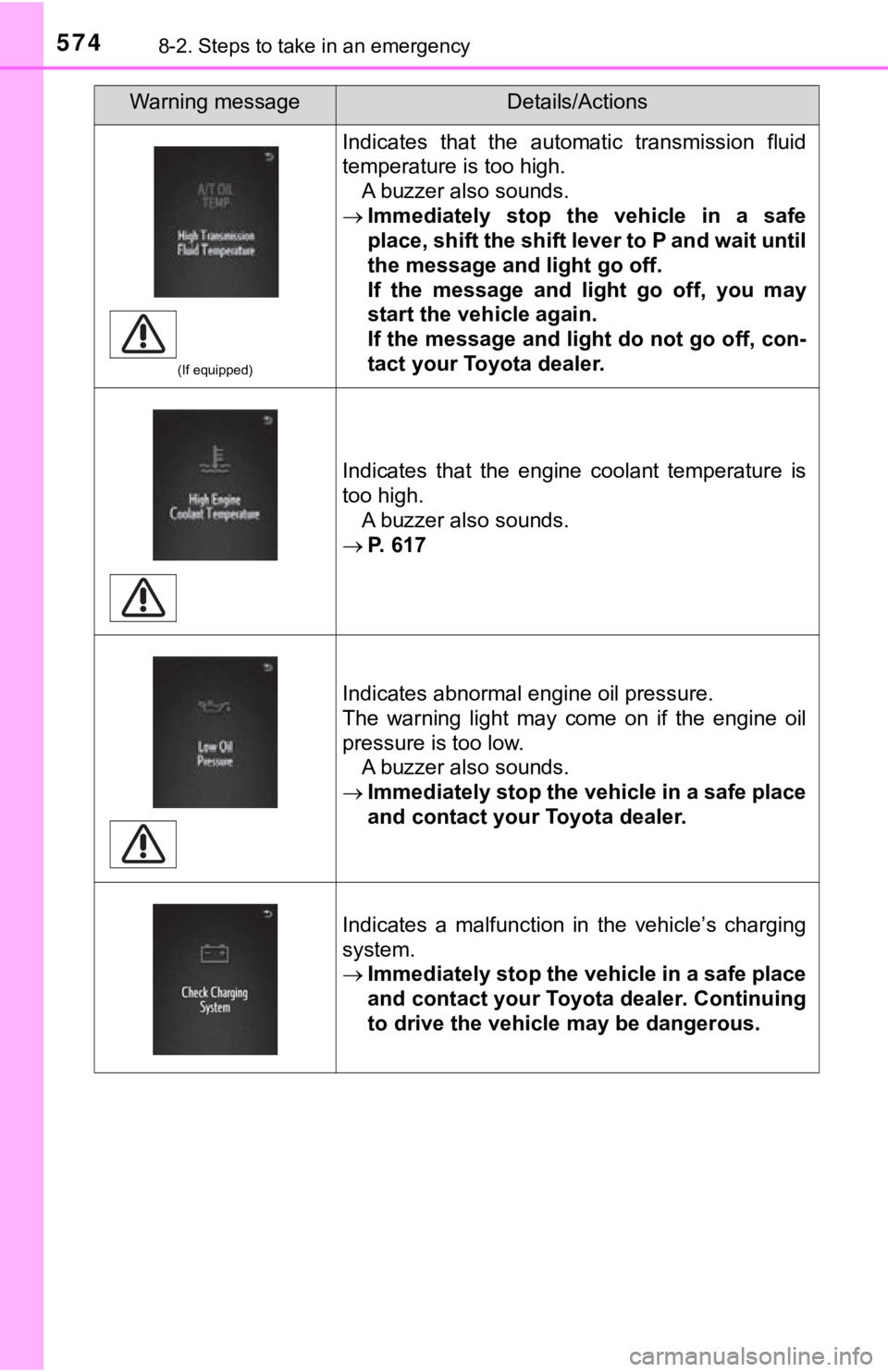
5748-2. Steps to take in an emergency
(If equipped)
Indicates that the automatic transmission fluid
temperature is too high.A buzzer also sounds.
Immediately stop the vehicle in a safe
place, shift the shift lever to P and wait until
the message and light go off.
If the message and light go off, you may
start the vehicle again.
If the message and light do not go off, con-
tact your Toyota dealer.
Indicates that the engine coolant temperature is
too high. A buzzer also sounds.
P. 617
Indicates abnormal engine oil pressure.
The warning light may come on if the engine oil
pressure is too low. A buzzer also sounds.
Immediately stop the vehicle in a safe place
and contact your Toyota dealer.
Indicates a malfunction in the vehicle’s charging
system.
Immediately stop the vehicle in a safe place
and contact your Toyota dealer. Continuing
to drive the vehicle may be dangerous.
Warning messageDetails/Actions
Page 617 of 696
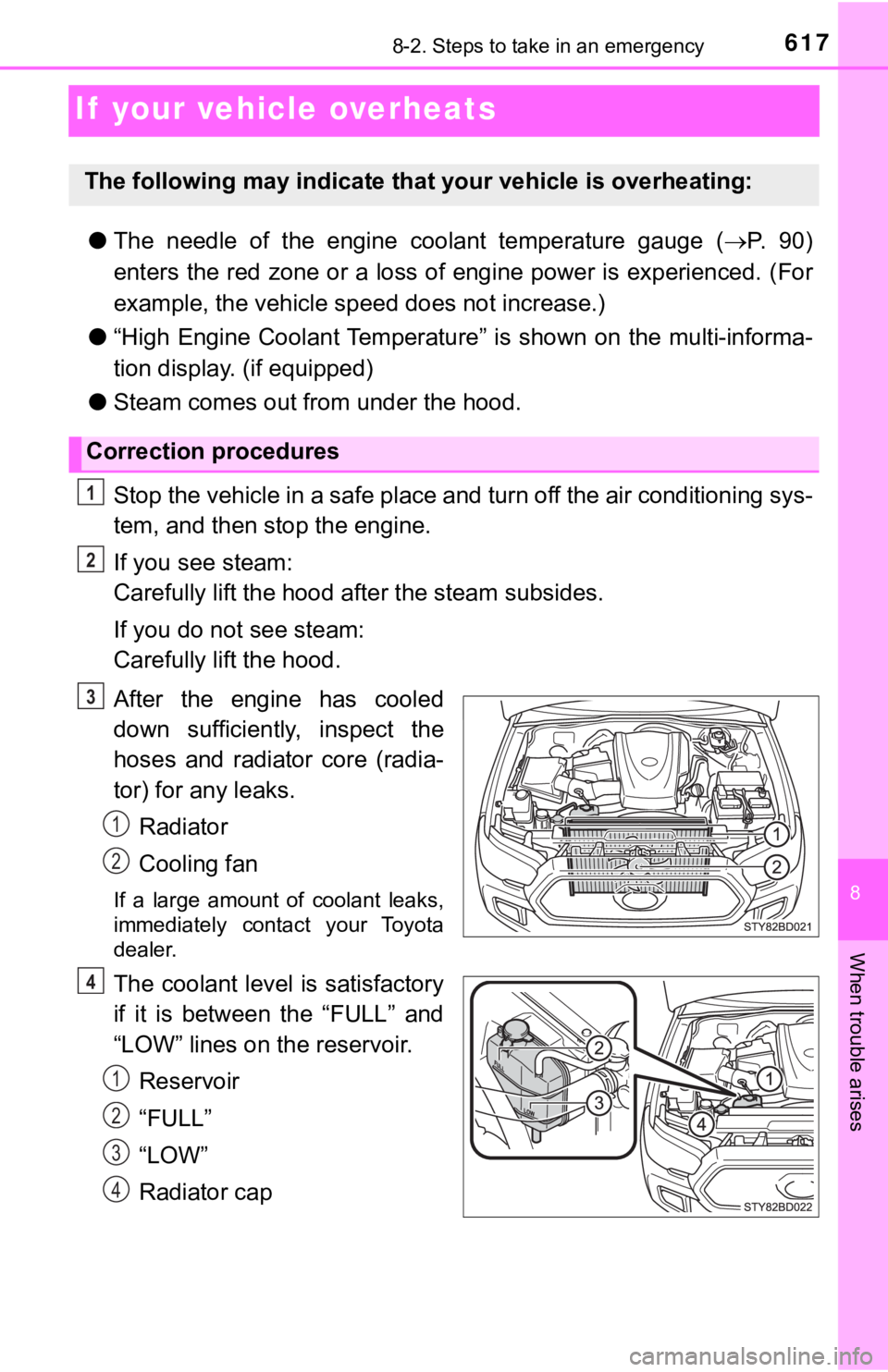
617
8
When trouble arises
8-2. Steps to take in an emergency
If your vehicle overheats
●The needle of the engine coolant temperature gauge ( P. 9 0 )
enters the red zone or a loss of engine power is experienced. ( For
example, the vehicle speed does not increase.)
● “High Engine Coolant Temperature” is shown on the multi-informa-
tion display. (if equipped)
● Steam comes out f rom under the hood.
Stop the vehicle in a safe place and turn off the air condition ing sys-
tem, and then stop the engine.
If you see steam:
Carefully lift the hood after the steam subsides.
If you do not see steam:
Carefully lift the hood.
After the engine has cooled
down sufficiently, inspect the
hoses and radiator core (radia-
tor) for any leaks. Radiator
Cooling fan
If a large amount of coolant leaks,
immediately contact your Toyota
dealer.
The coolant level is satisfactory
if it is between the “FULL” and
“LOW” lines on the reservoir.Reservoir
“FULL”
“LOW”
Radiator cap
The following may indicate that your vehicle is overheating:
Correction procedures
1
2
3
1
2
4
1
2
3
4
Page 618 of 696
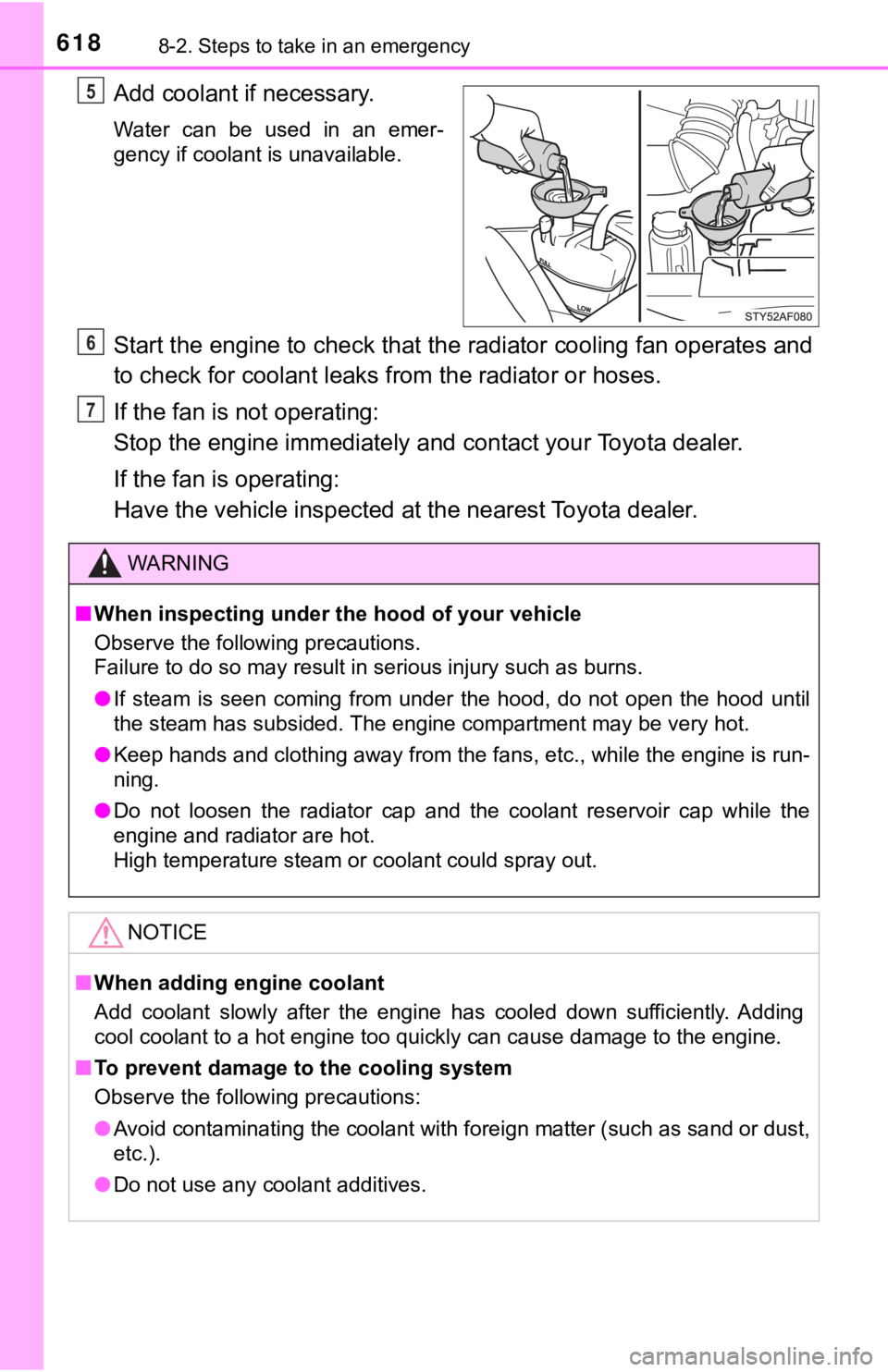
6188-2. Steps to take in an emergency
Add coolant if necessary.
Water can be used in an emer-
gency if coolant is unavailable.
Start the engine to check that the radiator cooling fan operates and
to check for coolant leaks from the radiator or hoses.
If the fan is not operating:
Stop the engine immediately and contact your Toyota dealer.
If the fan is operating:
Have the vehicle ins pected at the nearest Toyota dealer.
5
WARNING
■When inspecting under th e hood of your vehicle
Observe the following precautions.
Failure to do so may result in serious injury such as burns.
● If steam is seen coming from under the hood, do not open the ho od until
the steam has subsided. The engine compartment may be very hot.
● Keep hands and clothing away from the fans, etc., while the engine is run-
ning.
● Do not loosen the radiator cap and the coolant reservoir cap wh ile the
engine and radiator are hot.
High temperature steam or coolant could spray out.
NOTICE
■ When adding engine coolant
Add coolant slowly after the engine has cooled down sufficientl y. Adding
cool coolant to a hot engine too quickly can cause damage to th e engine.
■ To prevent damage to the cooling system
Observe the following precautions:
● Avoid contaminating the coolant with foreign matter (such as sa nd or dust,
etc.).
● Do not use any coolant additives.
6
7
Page 629 of 696
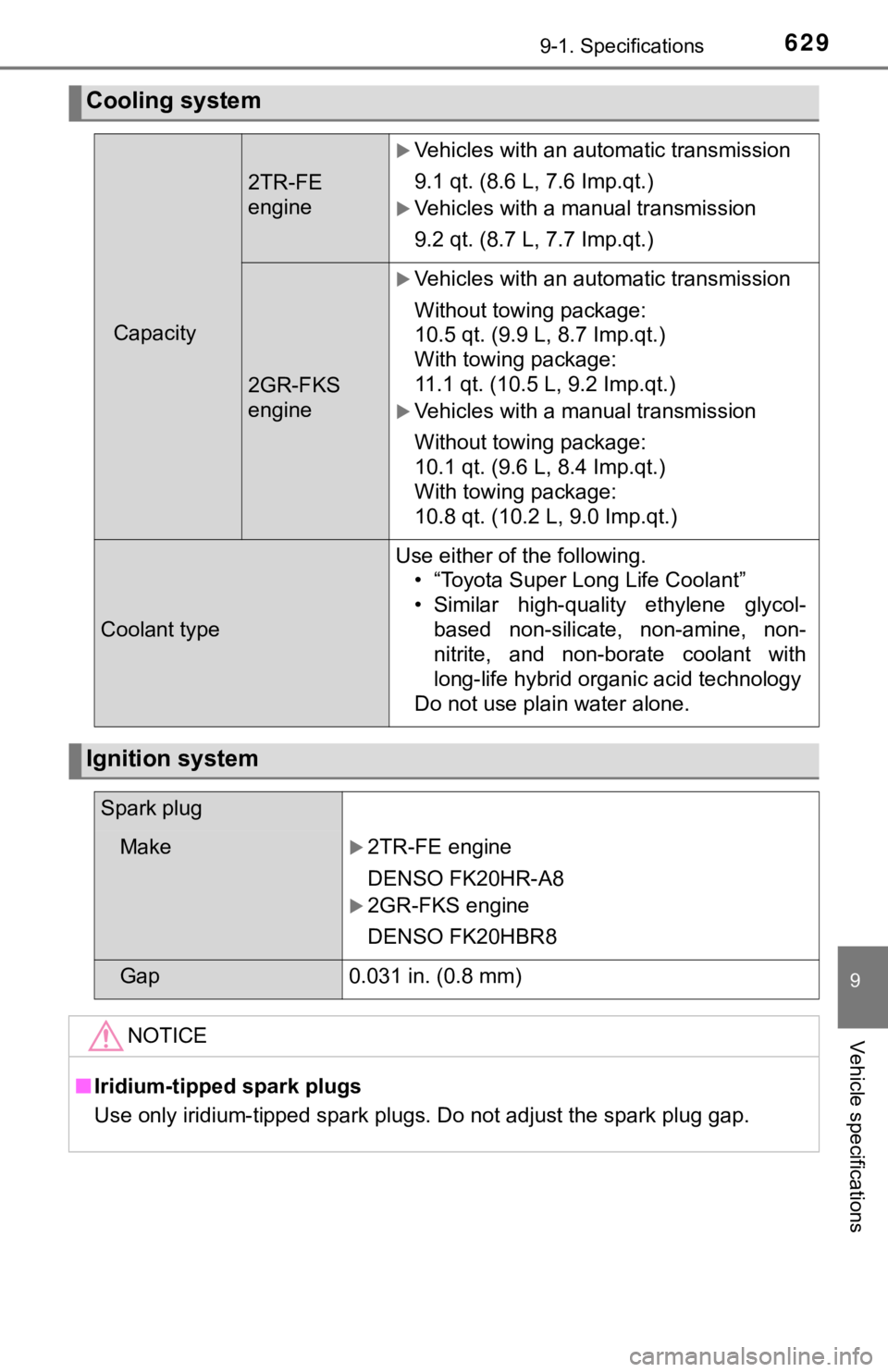
6299-1. Specifications
9
Vehicle specifications
Cooling system
Capacity
2TR-FE
engine
Vehicles with an automatic transmission
9.1 qt. (8.6 L, 7.6 Imp.qt.)
Vehicles with a manual transmission
9.2 qt. (8.7 L, 7.7 Imp.qt.)
2GR-FKS
engine
Vehicles with an automatic transmission
Without towing package:
10.5 qt. (9.9 L, 8.7 Imp.qt.)
With towing package:
11.1 qt. (10.5 L, 9.2 Imp.qt.)
Vehicles with a manual transmission
Without towing package:
10.1 qt. (9.6 L, 8.4 Imp.qt.)
With towing package:
10.8 qt. (10.2 L, 9.0 Imp.qt.)
Coolant typeUse either of the following.
• “Toyota Super Long Life Coolant”
• Similar high-quality ethylene glycol-
based non-silicate, non-amine, non-
nitrite, and non-borate coolant with
long-life hybrid organic acid technology
Do not use plain water alone.
Ignition system
Spark plug
Make2TR-FE engine
DENSO FK20HR-A8
2GR-FKS engine
DENSO FK20HBR8
Gap0.031 in. (0.8 mm)
NOTICE
■ Iridium-tipped spark plugs
Use only iridium-tipped spark plugs. Do not adjust the spark pl ug gap.
Page 644 of 696
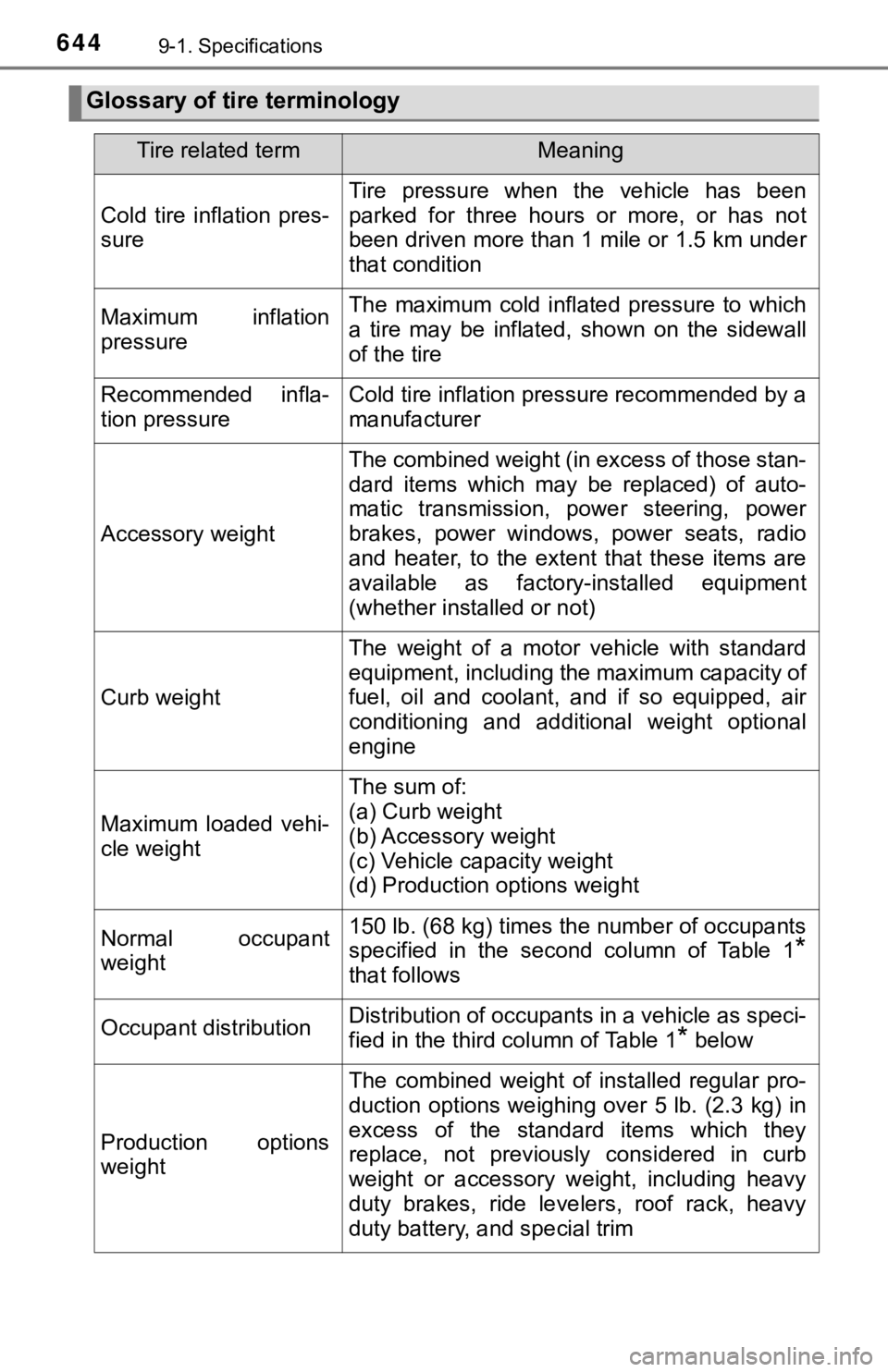
6449-1. Specifications
Glossary of tire terminology
Tire related termMeaning
Cold tire inflation pres-
sure
Tire pressure when the vehicle has been
parked for three hours or more, or has not
been driven more than 1 mile or 1.5 km under
that condition
Maximum inflation
pressureThe maximum cold inflated pressure to which
a tire may be inflated, shown on the sidewall
of the tire
Recommended infla-
tion pressureCold tire inflation pressure recommended by a
manufacturer
Accessory weight
The combined weight (in excess of those stan-
dard items which may be replaced) of auto-
matic transmission, power steering, power
brakes, power windows, power seats, radio
and heater, to the extent that these items are
available as factory-installed equipment
(whether installed or not)
Curb weight
The weight of a motor vehicle with standard
equipment, including the maximum capacity of
fuel, oil and coolant, and if so equipped, air
conditioning and additional weight optional
engine
Maximum loaded vehi-
cle weight
The sum of:
(a) Curb weight
(b) Accessory weight
(c) Vehicle capacity weight
(d) Production options weight
Normal occupant
weight150 lb. (68 kg) times the number of occupants
specified in the second column of Table 1
*
that follows
Occupant distributionDistribution of occupants in a vehicle as speci-
fied in the third column of Table 1
* below
Production options
weight
The combined weight of installed regular pro-
duction options weighing over 5 lb. (2.3 kg) in
excess of the standard items which they
replace, not previously considered in curb
weight or accessory weight, including heavy
duty brakes, ride levelers, roof rack, heavy
duty battery, and special trim
Page 685 of 696
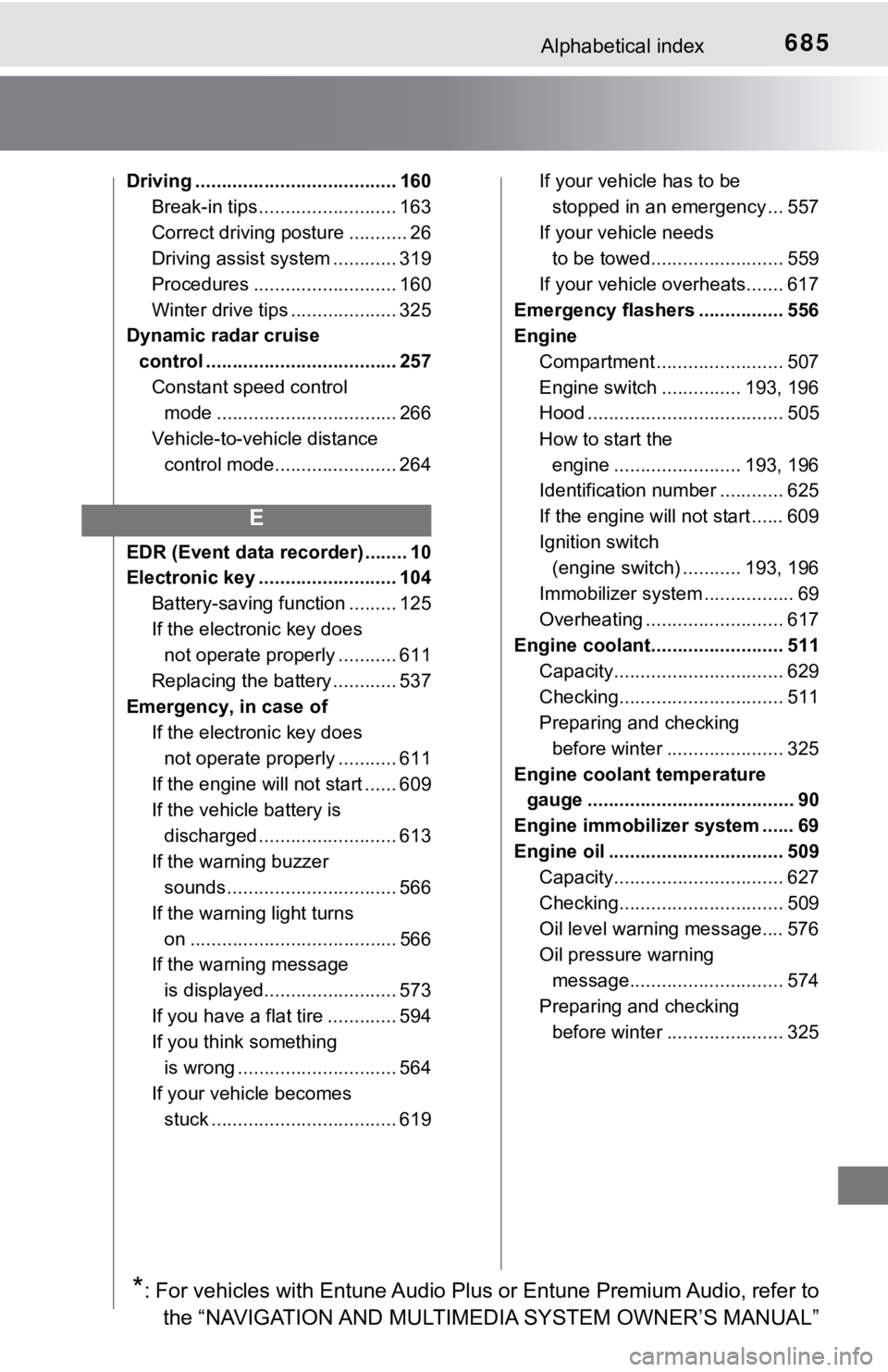
685Alphabetical index
Driving ...................................... 160Break-in tips .......................... 163
Correct driving posture ........... 26
Driving assist system ............ 319
Procedures ........................... 160
Winter drive tips .................... 325
Dynamic radar cruise
control .................................... 257 Constant speed control mode .................................. 266
Vehicle-to-vehicle distance control mode....................... 264
EDR (Event data recorder) ........ 10
Electronic key .......................... 104 Battery-saving function ......... 125
If the electronic key does not operate properly ........... 611
Replacing the battery ............ 537
Emergency, in case of If the electronic key does
not operate properly ........... 611
If the engine will not start ...... 609
If the vehicle battery is discharged .......................... 613
If the warning buzzer sounds ................................ 566
If the warning light turns on ....................................... 566
If the warning message
is displayed......................... 573
If you have a flat tire ............. 594
If you think something is wrong .............................. 564
If your vehicle becomes stuck ................................... 619 If your vehicle has to be
stopped in an emergency ... 557
If your vehicle needs
to be towed......................... 559
If your vehicle overheats....... 617
Emergency flashers ................ 556
Engine Compartment ........................ 507
Engine switch ............... 193, 196
Hood ..................................... 505
How to start the engine ........................ 193, 196
Identification number ............ 625
If the engine will not start ...... 609
Ignition switch (engine switch) ........... 193, 196
Immobilizer system .. ............... 69
Overheating .......................... 617
Engine coolant......................... 511
Capacity................................ 629
Checking............................... 511
Preparing and checking before winter ...................... 325
Engine coolant temperature gauge ....................................... 90
Engine immobilizer system ...... 69
Engine oil ................................. 509 Capacity................................ 627
Checking............................... 509
Oil level warning message.... 576
Oil pressure warning
message............................. 574
Preparing and checking before winter ...................... 325
E
*: For vehicles with Entune Audio Plus or Entune Premium Audio, refer to
the “NAVIGATION AND MULTIMEDIA SYSTEM OWNER’S MANUAL”